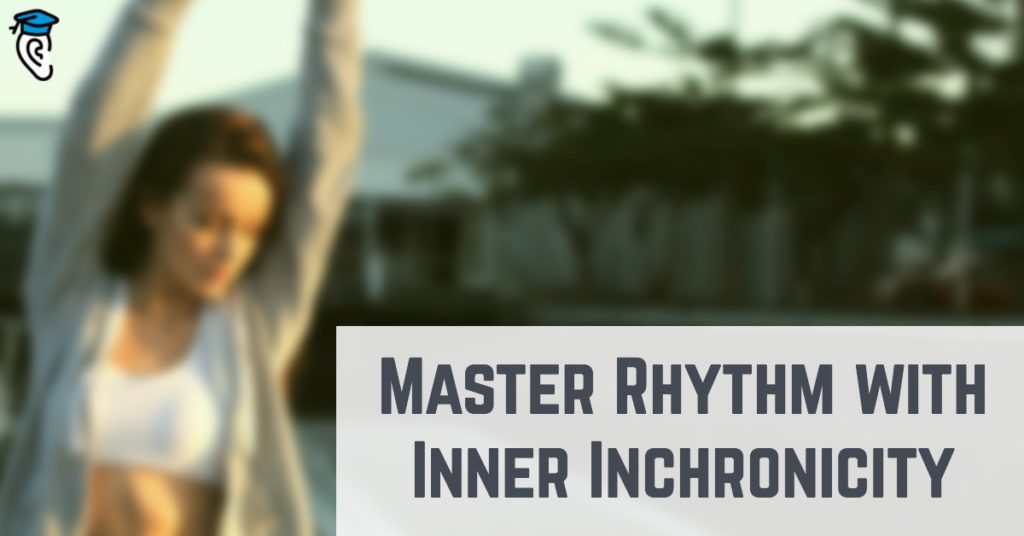A tightly-honed sense of rhythm is important for all musicians because rhythm is the gas in the music engine. Regardless of genre, having good rhythm skills can help you to sound more professional, synchronize with other musicians and be the creator of the all-important groove that draws in your audience.
Yet, rhythm is a weak point for many musicians and a frequently-overlooked part of their training. Lack of focus on rhythm is not limited to just those musicians who play melodic instruments – even percussionists fall prey to focusing on which notes to play instead of when.
We recently came across the theory of “Inchronicity” and asked its creator, Mac Santiago, about how his theory can help you to improve your rhythmic skills.
This is a summary post.
→ Read the full interview
Rhythm is Everyone’s Responsibility
When playing in an ensemble, everybody shares in the responsibility of keeping time. All players in a group have the ability to be the creators of time. It’s therefore the responsibility of all musicians to not only set the tempo but to maintain it throughout a song, not just one person.
In fact, when you rely solely on others to be the “timekeepers” in the group instead of your own internal metronome, you are prone to affecting the time one way or another. Keeping time is something everyone needs to “own” with confidence.
Follow the Tempo
There are many reasons why being a good follower of the tempo is so important. Firstly, since the tempo is the glue that holds the music together, following it is paramount to judging a successful performance at any level. Being a good follower of the tempo is what allows you to stay in sync with the other players in your ensemble.
When you hone this skill, you will not only be able to adjust to what you hear other players doing, but also to adjust accordingly to what you are being directed to do by the conductor or by colleagues. Following the tempo well helps you to clarify the moment of attack and the stating of your phrases, allowing for a crisp, professional performance.
The Struggle is Real
We asked percussionist, teacher and accompanist Mac Santiago his theory as to why so many musicians struggle with rhythm. The son of a drummer, Mac believes that rhythm often plays “second fiddle” to harmony and melody in western musical cultures. With the attention so often on the education of technical issues, Western and European musicians aren’t taught to dance to or to even to incorporate body movement in time to the music.
In a musical career of over 40 years, Mac has observed some professional musicians unable to tap in time to the music. This does not appear to be an issue in African music cultures, where the foundation and emphasis of much of the music is on rhythm instead of melody and harmony.
Beyond the Metronome
In an attempt to help musicians develop better rhythm, Mac created a method called “inchronicity”. The word “inchronous” is defined by Mac as “exhibiting an ability to play rhythm accurately in steady time without the aid of a metronome, recorded music, or other musicians… what many experienced musicians refer to as your internal clock.”
Mac explained his inchronicity method to us recently and in his book “Beyond the Metronome”. The inspiration to write the book and create the method came from hearing well-trained musicians, who were able to play with a click-track or a metronome, struggle in actual performances with rhythm.
Mac’s inchronicity method is designed to help all musicians create or maintain a steady tempo by weaning themselves off of the so called “tempo crutch”.
A “tempo crutch” is any external aid that prevents a musician from relying on their own inner clock such as a metronome, click track, or even the time-keeping of other players in the ensemble. Inchronicity works the same way that intonation clarifies melody and harmony: the more you use it, the cleaner your rhythm will become. Like other musical skills, your inchronous sense can be refined and “tuned-up” as your technique changes and grows.
Additional Advice
In addition to honing your inchronous sense, there are other ways in which you can improve your sense of rhythm. For example, try recording yourself and listen to the playback of your recording. What do you note with regards to your rhythm? Is it steady?
Also, don’t disregard advice as criticism. When someone says that you are rushing or dragging the tempo, look at it as a teachable moment and an opportunity to correct your mistakes.
Most of all, listen to other musicians and try to detect on your own when you are not in-sync with other players.
Developing a sense of inchronicity can be a potentially formidable tool in your musical arsenal and becomes even more important as music becomes more complex. By taking ownership of your rhythmic skills away from external influences, you might just stop taking the importance of time-keeping for granted and perhaps even prioritize rhythm above melody and harmony – if just for a moment.
After all, as Mac Santiago says, “A poorly-played note well placed is better than a well-played note placed poorly.”







